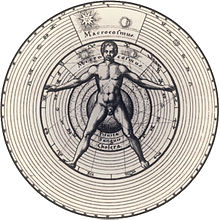Microcosm–macrocosm analogy
Appearance



Macrocosm and microcosm refers to a vision of cosmos where the part (microcosm) reflects the whole (macrocosm) and vice versa. It is a feature "present in all esoteric schools of thinking", according to scholar Pierre A. Riffard.[2] It underlies practices such as astrology, alchemy and sacred geometry.[3]
See also
References
- ^ Robert Fludd in Utriusque Cosmic Historia, II; quoted by Pierre A. Riffard in Dictionnaire de l’ésotérisme, Paris: Payot, 1983, 34.
- ^ Pierre A. Riffard, Dictionnaire de l’ésotérisme, Paris: Payot, 1983, 34.
- ^ Antoine Faivre, Access to Western esotericism, State University of New York Press, 1994, 10-11.
- Republic, Plato, trans. By B. Jowett M.A., Vintage Books, NY. § 435, pg 151
Bibliography
- Theories of Macrocosms and Microcosms in the History of Philosophy, G. P. Conger, NY, 1922, which includes a survey of critical discussions up to 1922.
External links
- Cosmos - an Illustrated Dimensional Journey from microcosmos to macrocosmos - from Digital Nature Agency
